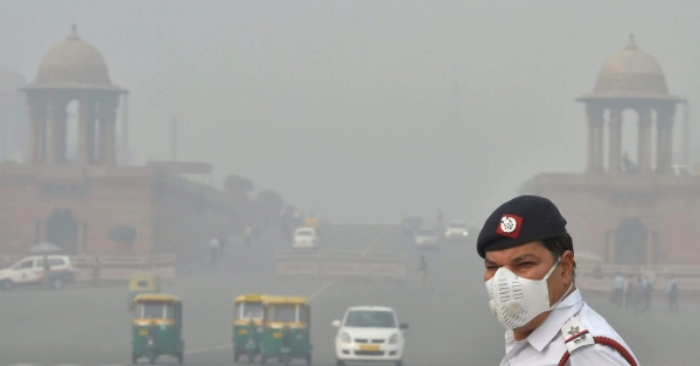Limit outdoor activities: Delhi-NCR air quality is nearing ’emergency’ levels.

New Delhi:
Over 4,000 farm fires contributed to 35% of Delhi’s pollution on Friday, pushing the 24-hour average Air Quality Index (AQI) to 471 by 4 p.m., the worst this season so far. On Thursday, it was 411.
According to a subcommittee on Graded Response Action Plan (GRAP), meteorological conditions will be highly unfavourable for pollutant dispersion until November 18, and agencies involved must be fully prepared to implement measures under the ’emergency’ category.
The Central Pollution Control Board (CPCB) reported that the 24-hour average concentration of lung-damaging fine particles known as PM2.5 in Delhi-NCR had reached 381 micrograms per cubic metre at 4 p.m. on Friday, more than six times the safe limit of 60 micrograms per cubic metre.
The PM10 level was 577 micrograms per cubic metre, which is more than five times the safe limit of 100 micrograms per cubic metre.
According to GRAP, air quality is considered an ’emergency’ if the PM2.5 and PM10 levels remain above 300 micrograms per cubic metre and 500 micrograms per cubic metre for 48 hours or more.
Following a review of the situation, the GRAP subcommittee stated, “Government and private offices, as well as other establishments, are advised to reduce vehicle usage by at least 30%.” (by working from home, carpooling, optimising field activities etc). It is recommended that people limit their outdoor activities and limit their exposure.”
“Concerned agencies must be fully prepared for the implementation of measures under the ’emergency’ category as per GRAP (Graded Response Action Plan),” the committee stated in an order.
The GRAP – a set of anti-pollution measures implemented in Delhi and its surrounding areas based on the severity of the situation – goes into effect in mid-October, when air quality levels begin to deteriorate.
The measures to be taken in a ’emergency’ situation include prohibiting trucks from entering Delhi, prohibiting construction activities, and instituting an odd-even car rationing scheme.
According to CPCB Member Secretary Prashant Gargava, the coming week is critical for Delhi-NCR air quality due to unfavourable meteorology, stubble burning, and poor dispersion, resulting in the accumulation of pollutants.
The CPCB stated that action-taken reports are received daily from the pollution control boards of Uttar Pradesh and Haryana, but those from the Delhi Pollution Control Committee and the Rajasthan State Pollution Control Board are still pending.
According to a Delhi Pollution Control Committee analysis, people in Delhi breathe the worst air between November 1 and November 15 of each year. Six of the last eight days following Diwali, the city experienced severe air quality.
At 4 p.m. on Friday, severe air quality was recorded in Faridabad (460), Ghaziabad (486), Greater Noida (478), Gurgaon (448), and Noida (488).
An AQI of zero to 50 is considered “good,” 51 to 100 “satisfactory,” 101 to 200 “moderate,” 201 to 300 “poor,” 301 to 400 “very poor,” and 401 to 500 “severe.”
A layer of eye-stinging smog lingering over Delhi-NCR thickened on Friday, giving the sun an orange tint and reducing visibility to 200 metres in some areas.
According to the India Meteorological Department, moderate fog, low temperatures in the morning – a low of 12.6 degrees Celsius on Friday – and calm winds have trapped pollutants close to the ground.
An AQI of zero to 50 is considered “good,” 51 to 100 “satisfactory,” 101 to 200 “moderate,” 201 to 300 “poor,” 301 to 400 “very poor,” and 401 to 500 “severe.”
A layer of eye-stinging smog lingering over Delhi-NCR thickened on Friday, giving the sun an orange tint and reducing visibility to 200 metres in some areas.
According to the India Meteorological Department, moderate fog, low temperatures in the morning – a low of 12.6 degrees Celsius on Friday – and calm winds have trapped pollutants close to the ground.
According to SAFAR, the Ministry of Earth Sciences’ air quality forecasting agency, stubble burning has been responsible for at least 25% of Delhi’s PM2.5 pollution for nine days in a row, beginning November 4.
According to Gufran Beig, the founder and project director of SAFAR, stubble burning generally contributes to PM2.5, but this time its coarser particles in PM10 are also becoming a lead pollutant in several Delhi locations.
“This is a new winter feature. This is primarily due to the particle growth mechanism caused by high humidity at night and increased humidity during the day, most likely due to water sprinkling, which increases the air’s holding capacity. Because the flow is consistent, many PM2.5 particles are accumulating towards PM10 (sic) “He stated.
On Sunday, the share of farm fires in Delhi’s pollution increased to 48%, the highest since November 5, 2018, when it was 58%.
Last year, on November 5, the share of stubble burning in Delhi’s pollution peaked at 42%. On November 1, 2019, it accounted for 44% of Delhi’s PM2.5 pollution.
Delhi Environment Minister Gopal Rai launched the second phase of a campaign to combat dust pollution on Friday. On Thursday, he launched a month-long campaign to prevent open waste and biomass burning in the city.






